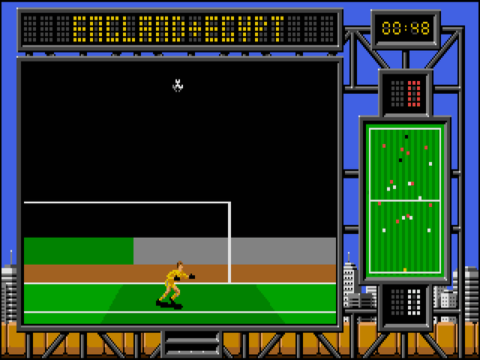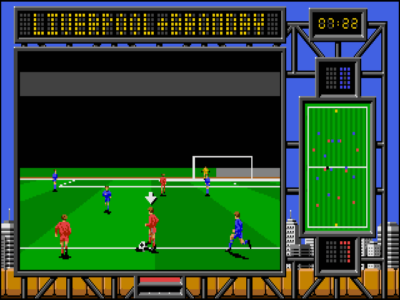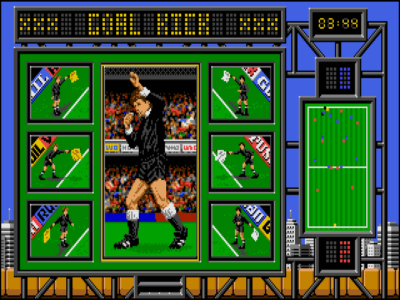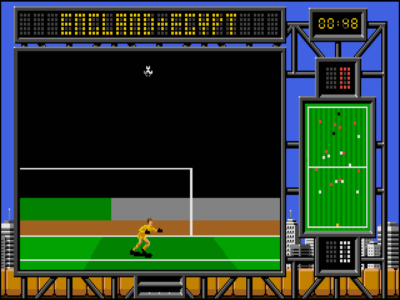
International Soccer Challenge
Written by: Rik
Date posted: April 2, 2017
- Genre: Sport
- Developed by: Red Rat Software
- Published by: MicroStyle
- Year released: 1990
- Our score: 3
My earliest PC gaming memories are of playing a handful of DOS games on a 386 that my Dad occasionally brought home from work (laptops were a bit of a luxury item in those days). At that point I sort of saw the PC as the slightly weird cousin of the 16-bit world, compared with the more genuine sibling rivalry of the Amiga (boo!) and Atari ST: better in some ways, but also somehow lagging behind in others.
Certainly, the world of DOS and hard drives was a lot smoother and faster than the floppy-swapping and weird green ST desktop I was used to, and I was particularly impressed with the way a new game of Championship Manager took moments to set up rather than 30-40 minutes. However, this particular PC wasn’t equipped with a sound card, so any joy derived from being able to play Stunts or Monkey Island 2 was mitigated by the blippy-bloopy noises emanating from the PC speaker. When we finally got a home machine with a Sound Blaster, there was a certain process of rediscovery with lots of games and finding out what their music and effects were supposed to sound like.
International Soccer Challenge never received that treatment, and the precise circumstances under which I first came to play it are now lost, but I do remember the eerie silence which accompanied the action on that old 386, with the occasional spot effects and the whirr of the cooling fan the only sounds to be heard. Some 25 years later, through the magic of DOSBox, it was quickly established that enabling Adlib sound produced no discernible aural enhancement, and so I was able to recreate almost the exact experience of largely soundless fake football on my laptop (to be fair, undisturbed by any whirring – that’s progress for you) that I had in the early nineties.
In a way the silence is fitting, as the action takes place in a seemingly empty stadium, with technological limitations meaning that in place of cheering supporters we have a vast dark abyss. Nets for the goals are also conspicuous by their absence, leaving you guessing – jumpers for goalposts style – whether shots have actually gone in or not. There’s a certain otherworldly, post-nuclear feel to proceedings, as if during the blasts elite football teams were hidden underground before emerging later to conduct international competition among what was left of the major towns and cities.
The view is at pitch level, kind of like Striker (although this was released earlier) and there’s been an attempt to subvert the usual issues associated with this perspective by making sure you’re always shooting away from the screen. (Which causes issues with defending, of course, but we’ll come to that). Out on the pitch, it’s an altogether slower affair than the cheery, fast and furious action of Striker, and arguably has slightly more in common with dreadful follow-up Striker ’95.
Passing and shooting is all controlled by one button: a power gauge determines the, er, power, while after-touch allows to you add height and bend after the ball leaves your player’s foot. It’s not a system that lends itself to a smooth passing game, and the most effective strategies involve hoofing it forward – sometimes directly into the net, as the keepers are particularly susceptible to lofted punts from the halfway line. Up close, they’re a bit more effective, though they decline to use their hands, often saving with their body or face before scrambling to kick the ball away. Still, there are a number of fairly reliable scoring options, aided by the extremely forgiving dribbling model, which is of the ball-sticks-to-your-feet variety.
Defensively things aren’t quite so easy, as the view makes it hard to line up your players and the slide tackle option only becomes active when you’re in the right position. Unusually, you can also foul someone just by running into them, and giving away penalties in such circumstances is frustrating, although they’re very rarely converted. An old trick in football games of a certain vintage was to have a separate sequence for penalty kicks so that any deficiencies in the main game relating to an inability to score from close range could be hidden. Here, they’ve not gone down that route, so winning or conceding a penalty rarely results in a goal being scored: a free kick just inside your opponents’ half is more dangerous. Anyway, the difficulty in regaining possession and the impressively clinical finishing of your opponents means that taking on the hardest available setting is less than appealing, which is a shame, as the others are incredibly easy to beat once you know what you’re doing.
As we mentioned, presentation is rather rudimentary, and in the absence of any crowd noise (or indeed a crowd) you’re left with a few whistles and thuds, and a couple of brief tunes that accompany scoreboard displays of a happy or sad face depending on whether you’ve just scored or conceded a goal (the latter of which could very easily be turned into an animated GIF or meme to use during arguments on social media). There are no striped kits, or indeed any kits other than one uniform colour (there’s also the faintly embarrassing sight of all-white African teams, which was fairly common at the time, and while obviously not part of a deliberately racist conspiracy among developers of football games, it nevertheless seems rather jarring now).
There are also no tactics, no player names and no stats, and two tournaments are your lot: a World Cup for international teams and a Super League for club sides. The former does make some concessions to a big event tournament with a few stills acknowledging success or failure along the way. I know this sounds like quite a small thing but I always appreciate it when developers make some effort to acknowledge significant victories – I used to find it extremely cruel to have beaten a football game only to be greeted by a swift return to the main menu.
There’s also an option to play as an individual rather than the whole team, although this promising-sounding concept actually just means that the computer doesn’t automatically switch control to the player nearest the ball, and a press of the fire button rectifies this at any point. So you’re not actually locked into controlling a nominated player on the pitch, and thus there’s not a great deal of difference between the two modes. Without the camera tracking the ball in this mode, though, it does allow you to stand on the halfway line and exchange lofted punts with the opposition goalkeeper, which provides some level of mild and short-lived amusement value.
And, er, that’s about it. I did have a look through the manual but despite it being unnecessarily complicated and going into great detail about hidden gameplay depths, there was nothing significant to add that wouldn’t be obvious to most from actually playing the game. For those of us who have an urge to revisit old football games and find a base pleasure in working them out and trying to beat them, there’s a few hours of entertainment here. For everyone else, International Soccer Challenge is a pretty daft old thing, and other than the fact that it’s aged a little better than I expected, there’s little other more specific or generous praise I can really give it. Ah well.






 Posts
Posts